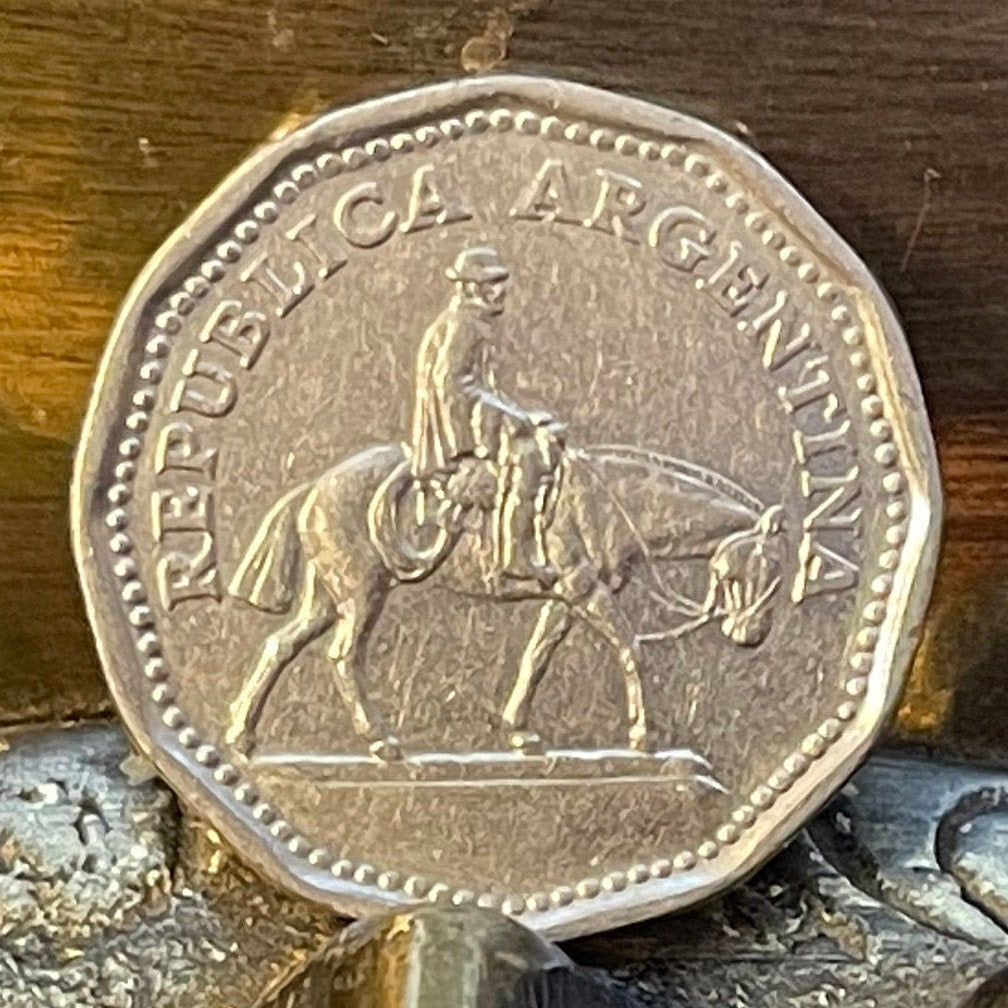elemintalshop
El Gaucho Resero Statue 10 Pesos Argentina Authentic Coin Money for Jewelry (Buenos Aires) (Cowboy) (Herdsman) (Dodecahedron)
El Gaucho Resero Statue 10 Pesos Argentina Authentic Coin Money for Jewelry (Buenos Aires) (Cowboy) (Herdsman) (Dodecahedron)
Couldn't load pickup availability
El Gaucho Resero 10 Pesos Argentina Authentic Coin Money for Jewelry and Craft Making (Buenos Aires)(Cowboy) (Herdsman) (Emilio Jacinto Sarniguet)
Obverse: The statue of "El Resero", depicting a man riding a horse
Lettering: REPUBLICA ARGENTINA
Translation: Republic of Argentina
Reverse: A branch to the left of the value and year, with the value above
Lettering: 10 PESOS
Features
Issuer Argentina
Period Federal Republic (1861-date)
Type Standard circulation coin
Years 1962-1968
Value 10 Pesos (10 ARM)
Currency Peso moneda nacional (1881-1969)
Composition Nickel clad steel
Weight 4.9 g
Diameter 23 mm
Thickness 1.8 mm
Shape Dodecagonal (12-sided)
Orientation Coin alignment ↑↓
Demonetized 01-01-1970
Number N# 955
References KM# 60, Schön# 60, CJ# 281-287
Wikipedia:
The equestrian monument "El Gaucho Resero" , also known simply as "El Resero", is an icon of the Mataderos neighborhood, Buenos Aires, Argentina .
The work was commissioned in 1929 by the Municipality of said city to the sculptor Emilio Jacinto Sarniguet to be placed at the entrance of the so-called "Mercado de Liniers". Completed in 1932, it won the first prize at the National Salon that year.
In 1934 it was located in the place where it still is: the small square located on Avenida Lisandro de la Torre at 2300, opposite Avenida de los Corrales and in front of what was the entrance to the aforementioned market.
Issues from 1962 to 1968 of the Argentine national coins of 10 pesos had an image of this work engraved on one of their faces.
********
Around 1962 he became well known when he appeared in the engraving of one of the sides of the 10 peso coins . The coinage generated a debate: the horse had its right legs forward and its two left-handed ones back. Critics pointed out that it was enough to see the movement of any horse to understand that it is crossed. But they were wrong: the sculptor took into account that the herdsmen used to use the pasucos , which move the hand and the leg on the same side so that their gait is more relaxed and that allows the rider to travel rested and even sleep while walking.
******
A gaucho (Spanish: [ˈɡawtʃo]) or gaúcho (Portuguese: [ɡaˈuʃu]) is a skilled horseman, reputed to be brave and unruly. The gaucho is a symbol in Argentina, Uruguay, Rio Grande do Sul state in southern Brazil, and the southern Chilean Patagonia. Gauchos became greatly admired and renowned in legends, folklore and literature and became an important part of their regional cultural tradition. Beginning late in the 19th century, after the heyday of the gauchos, they were celebrated by South American writers.
The gaucho in some respects resembled members of other nineteenth century rural, horse-based cultures such as the North American cowboy (vaquero in Spanish), huaso of Central Chile, the Peruvian chalan or morochuco, the Venezuelan and Colombian llanero, the Ecuadorian chagra, the Hawaiian paniolo, the Mexican charro, and the Portuguese campino.
According to the Diccionario de la lengua española, in its historical sense a gaucho was a "mestizo who, in the 18th and 19th centuries, inhabited Argentina, Uruguay, and Rio Grande do Sul in Brazil, and was a migratory horseman, and adept in cattle work". In Argentina and Uruguay today gaucho can refer to any "country person, experienced in traditional livestock farming". Because historical gauchos were reputed to be brave, if unruly, the word is also applied metaphorically to mean "noble, brave and generous", but also "one who is skillful in subtle tricks, crafty". In Portuguese the word gaúcho means "an inhabitant of the plains of Rio Grande do Sul or the Pampas of Argentina of European and indigenous American descent who devotes himself to lassoing and raising cattle and horses"; gaúcho has also acquired a metonymic signification in Brazil, meaning anyone, even an urban dweller, who is a citizen of the State of Rio Grande do Sul.
Share










5 stars review from Dawn
Love it !!
5 stars review from Elisabeth









